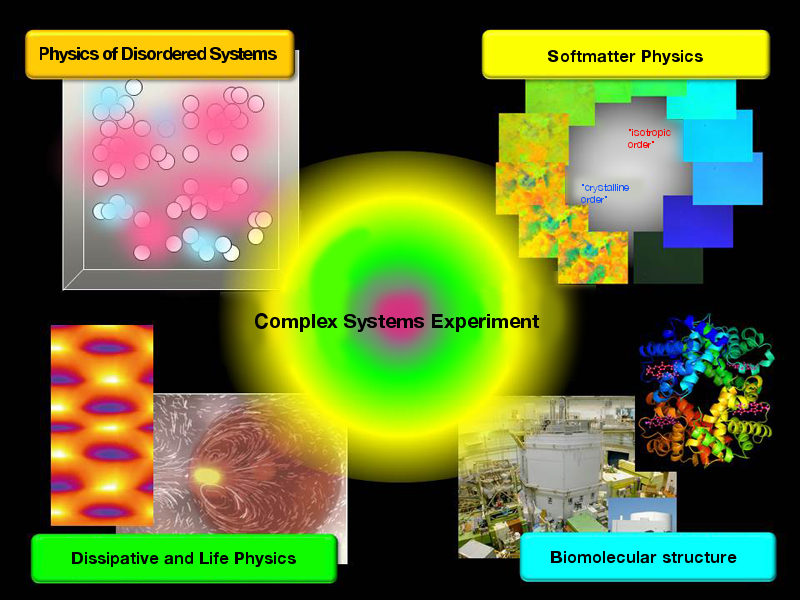Disordered systems、soft matter、Dissipative and Life Physics、Structure of Life、Quantum Beam
(Life Science and the Structure of Life、Nonlinear Non-Equilibrium Dynamics、Group- and Cooperative Phenomena(movement), Nano- and Mesoscopic-Science)
The experimental complex systems group studies various states of matter such as disordered and isotropic liquid phases, three-dimensional systems without perfect translation symmetry, and low-dimensional ordered systems. The objects of our interest are complex and highly-functional systems, which are often related to our everyday-lifes, such as clusters, liquid metals, ionic liquids, soft matter, liquid crystals, polymers, bimolecular membranes, colloids, emulsions, proteins, biopolymers, and glasses.
Our challenge is to reach the same understanding of physics for such heterogeneous materials, which are a conglomerate of many particles, have many degrees of freedom, consist of different components, and where the topological structure of the contact interface results in many different intermediate states. Moreover, the phase transitions between these states become the treasure chamber for statistical physics and their basic theoretical models.
Seeing the hierarchical structure and super-structure of the components of complex systems ranging from atoms, electrons, ions, molecules, macromolecules, to even supramolecules, which spann a wide range from microscopic to macroscopic scale including on the intermediate even mesoscopic scales, discoveries of materials with new symmetries and their explanations can be expected.
For this purpose, we utilize various quantum beams with different wavelengths such as X-ray, neutron beam, free electron laser, visible / UV laser to clarify the spatial symmetry and superstructure.
Complex systems exhibit simultaneously both elasticity like a solid (crystal) and viscosity like a liquid (fluid), showing a unique dual nature. In addition, nonlinear and non-equilibrium dynamics, which is caused by coupling of multiple degrees of freedom with different scales, plays an important role. Furthermore, in low dimensional system, few particles can lead to large-scale fluctuations, and thus to very characteristic behavior.
To understand the dynamics of these systems and approach the physical essence of the seen phenomena, various different probes and time- as well as energy-resolved spectroscopy is used. Last but not least, we challenge the boundaries between physics, chemistry and biology, by investigating active matter with energy sources inside the substance, such as molecular motors and reactive diffusion systems.

In nature there are many phenomena that traverse the hierarchical structure, including quantum phenomena and non-equilibrium processes. In this group, in order to study these phenomena in the laboratory, we study the microscopic and macroscopic properties of liquids and clusters (several to tens of thousands of atoms), which are related to electronic- and atomic-system, by using synchrotron radiation and X-ray free electron laser (XFEL).
Research subjects are spontaneously moving particles and life phenomena, which change in time. We aim to clarify the principle behind complicated phenomenon by understanding branching, phase transition, etc. in simple systems.
Soft matter physics is physics that studies soft substances ranging from liquid crystal, polymer, emulsion to biological structure. Soft matter has a heterogeneous self-organizing hierarchical structure on every scale, from microscopic to macroscopic. inside the steps from nanoscale to macro. In this group, we use various methods to measure the structure and dynamics of substances, create new soft matters, develop functionalities, and elucidate its laws.
We perform experiments to clarify the structure and crystal structure of materials and understand it from a microscopic standpoint. Specifically, we use single crystals of biomaterial, compounds and hydrogen compounds, and study the mechanism mainly by means of neutron scattering and X-ray scattering. Furthermore, our research extends to the study of physical properties such as the three-dimensional structure and dynamics of biopolymers, and clarification of the relation between their structure and functionality.